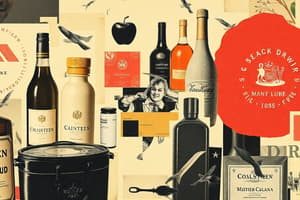Podcast
Questions and Answers
Which product classification is best described as goods purchased for personal use, such as toiletries?
Which product classification is best described as goods purchased for personal use, such as toiletries?
- Industrial Goods
- Consumer Goods (correct)
- Shopping Goods
- Undifferentiated Products
Products that are hard to distinguish from each other due to their similar physical characteristics are known as:
Products that are hard to distinguish from each other due to their similar physical characteristics are known as:
- Differentiated products
- Specialty goods
- Undifferentiated products (correct)
- Convenience goods
Which of these would be considered a consumable product, based on its short period of benefit?
Which of these would be considered a consumable product, based on its short period of benefit?
- Detergent (correct)
- Refrigerator
- Luxury car
- Designer clothing
A candy bar is an example of which product type, due to its frequent purchase and low price?
A candy bar is an example of which product type, due to its frequent purchase and low price?
Which of these best describes the marketing service attribute of 'intangibility'?
Which of these best describes the marketing service attribute of 'intangibility'?
What is a 'core benefit' of a product?
What is a 'core benefit' of a product?
Which type of competitor is most accurately described as a company that fulfills the same customer need but offers a different product?
Which type of competitor is most accurately described as a company that fulfills the same customer need but offers a different product?
Which of these is NOT a core goal of marketing, according to the text?
Which of these is NOT a core goal of marketing, according to the text?
Flashcards
Consumer Goods
Consumer Goods
Goods purchased for personal or household consumption, like toiletries.
Industrial Goods
Industrial Goods
Goods purchased to produce other goods or as raw materials.
Differentiated Products
Differentiated Products
Products with unique features making them stand out from competitors.
Convenience Goods
Convenience Goods
Signup and view all the flashcards
Intangibility
Intangibility
Signup and view all the flashcards
Direct Competitors
Direct Competitors
Signup and view all the flashcards
Core Benefit
Core Benefit
Signup and view all the flashcards
Core vs Formal Product
Core vs Formal Product
Signup and view all the flashcards
Study Notes
Augmented Product
- Extra features or services that differentiate a product from its competitors.
Classification of Products/Goods
According to Use
- Consumer Goods: Purchased for personal or household use (e.g., soaps, food).
- Industrial Goods: Purchased to create other goods or used as raw materials (e.g., raw materials, tools).
According to Differentiations
- Undifferentiated Products: Products with similar physical characteristics, making it hard to distinguish them from vendors (e.g., generic products).
- Differentiated Products: Products with distinct characteristics, making them recognizable from other vendors (e.g.,branded products).
Branding
- The ability of manufacturers to differentiate their products from competitors through a unique name, logo, symbol, or image.
According to Durability
- Consumable: Products used by consumers for a short period (e.g., toiletries, detergents).
- Semi-durable: Products lasting for several months (e.g., appliances).
- Durable: Products lasting for a long time (e.g., furniture).
According to Type
- Convenience Goods: Frequently purchased, inexpensive, and requiring minimal effort to buy (e.g., snacks, common beverages).
- Shopping Goods: Less frequently purchased, more expensive, requiring some effort to evaluate and buy (e.g., clothes, appliances).
- Specialty Goods: Goods requiring significant effort to buy (e.g., luxury items, designer items).
- Unsought Goods: Goods that consumers may not actively seek out, bought for occasions like emergencies (e.g., life insurance).
Marketing Services
- Intangibility: Services cannot be touched.
- Variability: Services performed by humans vary from one time to the next.
- Inseparability: Both the service provider and consumer are present at the same time.
- Perishability: Services cannot be stored.
Needs and Wants
- Consumer needs result from physiological needs which include food, shelter, and clothing.
Types of Competition
- Desire Competitors: Competitors offering a similar product, which often start by understanding the customer's needs.
- Generic Competitors: All available product options.
- Brand Competitors: Offering the same product type.
- Form Competitors: Substitutes that meet the same need.
Marketing
- Activities for creating, communicating, and exchanging value for customers and society.
- Goals aim to understand the customer, develop products/services that improve human life, and generate profits.
Product
- The item offered for sale; can be a service or a physical/virtual item. Each product has a cost.
Levels of Products/Services
- Core Benefit: Fundamental need met by the product (e.g., need for transportation).
- Formal Product: Product attributes like design, brand, price (e.g., features and design of a car, its brand, and price).
Studying That Suits You
Use AI to generate personalized quizzes and flashcards to suit your learning preferences.




